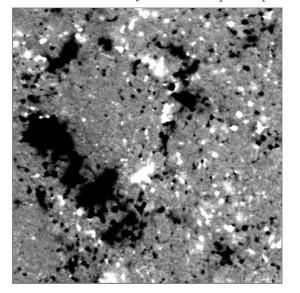
The cause of space climate is the long term solar magnetic activity. The origin of 22-year solar magnetic cycle lies below the solar photosphere, where large scale meridional flows, differential rotation, and multiscale plasma motions, due to turbulent convection, work jointly to produce magnetic fields. The source of such magnetic fields is the hydromagnetic dynamo process able to sustain the magnetic field through the non-axisymmetric turbulent motions inside the solar convective zone. The most powerful intensity and velocity signals are associated to convection cells, called granules, with a scale of typically 1 Mm and a lifetime of about 5-10 minutes. Small-scale magnetic elements, ubiquitously on the solar photosphere, are passively transported by convective plasma flows. This process of advection makes their traces very suitable to define the convective regime of the photosphere and to trace the boundaries of the underlying convective cells. The solar photosphere offers an exceptional opportunity to investigate convective motions, associated to compressible, stratified, magnetic, rotating and large Rayleigh number plasmas. All these physical properties are currently inaccessible to realistic numerical simulations of large volumes of the Sun or to laboratory experiments.

The spectropolarimetric dataset used to detect and track magnetic elements is an uninterrupted 25 hours long sequence of 995 magnetograms with a cadence of 90s. The mean square displacement may be modeled with a power law with spectral index γ. We found a spectral index γ=1.34±0.02 for times up to ∼2000s and γ=1.20±0.05 for times up to ∼10000 s. An alternative way to investigate the advective/diffusive motion of the magnetic elements is to look at the evolution with time of the 2D probability distribution function of the displacements with time. While for times shorter than ∼2000 s the PDFs symmetrically broaden for increasing time, at longer times it emerges a multi-peaked feature of the PDFs, which suggests a non-trivial nature of the diffusion/advection process of magnetic elements. The Voronoi distribution analysis shows that the observed small-scale distribution of SMESs involves the complex details of highly nonlinear small-scale interactions of turbulent convective flows detected in solar photospheric plasma.
Journal of Plasma Physics / Volume 81 / Issue 05 / October 2015, 495810514 (13 pages)




More Stories
Stage a Tor Vergata: Summer 2019
A night at the University.
ESCAPE Project Press Release